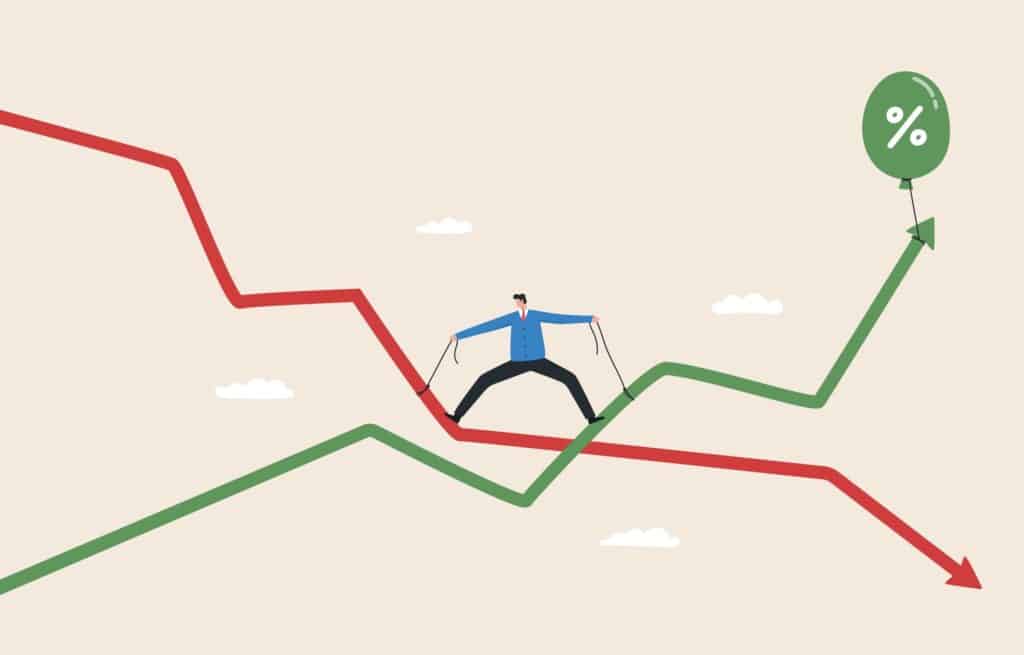
For the eighteenth month, Freedom Finance Global has been researching consumer confidence, inflation and devaluation expectations of residents of four Central Asian countries: Kazakhstan, Uzbekistan, Kyrgyzstan and Tajikistan. In December 2024, an ambiguous trend in consumer confidence was observed. Growth in Kazakhstan was overshadowed by a decline in Tajikistan, while the other two countries demonstrated neutral dynamics. Nevertheless, there has been a slight improvement in the dynamics of inflationary sentiment in almost all countries after the sharp deterioration in November. Devaluation expectations have decreased in the region as a whole, but in this aspect, Kazakhstan continues to stand out amid the weakening tenge.
The year 2024 ended with moderately negative trends for the region. While Kyrgyzstan has shown significant annual progress in consumer confidence, this is not the case in other countries. The past year was not the best for the Uzbekistanis, and amid improvement in neighboring countries in the Central Asian region, Uzbekistan is losing second place at the end of the year. Tajikistan, although it continues to hold the palm tree, also ended the last year by switching to moderately negative trends. But for Kazakhstan, 2024 was a neutral year, consumer confidence remained virtually unchanged. Nevertheless, the CCI of the Central Asian countries is still above the neutral border of 100 points, this indicates the predominance of positive responses over negative ones.
In Kazakhstan and Uzbekistan, analysts collect 3,600 questionnaires each month, 1,600 in Kyrgyzstan and 1,200 in Tajikistan, pro rata the size of the population in the countries under research. The research is based on the methodology used to obtain consumer confidence indexes in many countries around the world and adapted to local needs by the United Research Technologies Group company. Data collection method: telephone survey. The survey questionnaire is localized: the research is conducted in the native language of the respondents.
Kazakhstan
In Kazakhstan, the Consumer Confidence Index demonstrated a noticeable recovery in December after the November drop and amounted to 104.8 points, which was the second-highest indicator for the entire research. The respondents’ sentiments improved across all five sub-indexes. It should be noted that the consumer confidence of residents remained virtually unchanged in 2024 and increased by only 0.1 points (the December 2024 figure compared to the December 2023 figure). In general, Kazakhstanis have become more pessimistic about their personal financial situation; however, this was offset by an improvement in estimates of favorable conditions for large purchases.
Restoring forecasts for the personal financial situation
The sub-index of the forecast of changes in personal financial situation over the next 12-month horizon recovered by 4.5 points, and returned to the October level of 132.5 points. The share of those who believe that their personal financial situation will improve increased from 47.2% in November to 50.8% in December. However, compared to the end of 2023, this figure turned out to be noticeably lower. A year ago, the share of optimists was 53%.
Among the age groups, the monthly increase in optimism occurs in all groups. The most noticeable improvement is recorded among young people under the age of 29, where the share of positive respondents increased from 61.3% to 66.5%. This indicator is the best among all age groups by a wide margin. Representatives of the older generation over the age of 60 answered the worst of all. However, there is also an increase in optimism among them: 35,9% of Kazakhstanis chose positive answers against 32.5% in November.
In the regional context, the greatest increase in optimism regarding forecasts of changes in personal financial situation is observed in the Kyzylorda and West Kazakhstan Regions, where the share of positive responses increased by 13 and 11 p.p., respectively. As a result, the representatives of the southern region demonstrated the best result in December. Residents of the North Kazakhstan Region answered the worst of all, where the share of those predicting an improvement in their personal financial situation in the next 12 months was only 37.6%. Moreover, this indicator decreased by 8.3 p.p. compared to November.
Restoring conditions for large purchases
The sub-index of estimates of favorable conditions for large purchases recovered by 4.1 points compared to November and reached 74 points. This result turned out to be the best in the last 4 months and was 3.3 points higher than at the end of 2023. The share of Kazakhstanis who believe that the current conditions for large purchases are favorable increased from 30% to 31.8%. At the same time, a year ago this figure reached only 29.3%.
Among the age groups, only respondents aged 30-44 showed a noticeable increase in optimism. The share of positive responses increased from 27.8% to 31.8% among them, and this was the second result among the age groups. Young people under the age of 29 answered the best: 38.1%, but this figure is slightly higher than it was in November. People over the age of 60 continue to respond the worst with a result of 26.8%, which, however, is 1.8 p.p. higher than in November.

The West Kazakhstan Region demonstrated the most noticeable improvement, where the share of positive responses increased from 19.7% to 37%. Nevertheless, Mangystau Region turned out to be the leader in December with a score of 39.6%, which is significantly higher – by 11% than in November. There is also a noticeable monthly improvement in the Kostanay, Atyrau and Abay regions, where the growth of a similar proportion of optimists amounted to 6-8 p.p. On the other hand, the respondents from the Zhetysu region showed the worst result, where the share of positive responses was only 22.4%, which is significantly lower than the national average.
Inflation estimates and expectations showed different dynamics
Inflation estimates of Kazakhstan residents have shown growth for the second month in a row. Over the past month, 42.6% of respondents (40.9% in November) indicated a strong increase in prices. Moreover, over the year horizon, the share of those who noticed a rapid increase in prices increased at a similar rate: from 49.9% in November to 52.4% at the time of the last data collection. Nevertheless, these figures fell by 5-6 p.p. compared to last year, when inflation was slightly higher.
The inflation expectations of Kazakhstanis showed a decrease, in contrast to the estimates after the annual maximums in November. The share of people expecting a strong increase in prices in the one-month horizon fell sharply from 30.6 to 24.7%, while in the next 12 months horizon, the share of those expecting an acceleration in price growth decreased from 27.5% in November to 25.6% at the time of the last survey.
A similar research of inflation estimates and expectations performed by the National Bank of Kazakhstan demonstrated similar dynamics in terms of estimates, but not in terms of expectations. According to the data presented, the share of those expecting strong price growth over the year has increased sharply from 22 to 30.2%. While on a one-month horizon, the same indicator has increased from 27.1 to 32.8%. Both of these indicators turned out to be the highest since December 2022. Inflation estimates also showed a more noticeable increase. While the share of respondents who estimated price growth over the past month has increased from 32.4 to 37.8%, the share of those who indicated rapid price growth over the previous 12 months has increased from 40.2 to 45%.
Among certain goods and services, the majority of Kazakhstanis continue to be concerned about the significant increase in food prices. The top four goods that have risen in price most noticeably, according to the population, have remained unchanged for the sixteenth month in a row. They include the categories ‘Meat and Poultry’, ‘Milk and Dairy Products’, ‘Bread and Bakery Products’ and ‘Vegetables and Fruits’. The share of people who noticed a strong increase in prices for all of the above products increased by an average of 1.9 p.p. compared to November, which corresponds to the survey of inflation estimates. The share of those who noted a strong increase in prices for bread and bakery products increased most noticeably: from 21.1 to 23.6%. Nevertheless, the following goods showed the strongest growth rates (4-5 p.p.): vegetable oil, flour and tea with coffee. According to official statistics, bread prices rose by only 0.2% MoM in December, while vegetable oil prices rose by a notable 2.9% MoM. We also note a more significant monthly increase in coffee prices (0.8% MoM).
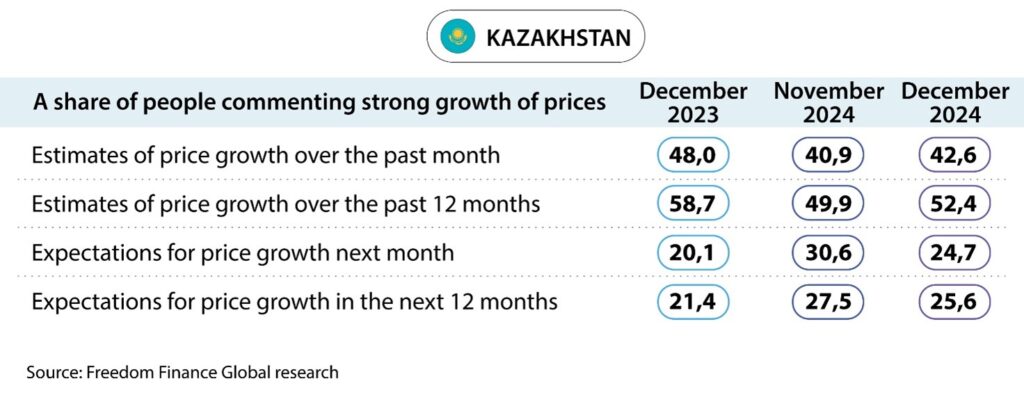
Devaluation expectations break records again
Devaluation expectations of Kazakhstanis have been growing for the third month in a row and have updated record values for the entire research amid an increase in the dollar exchange rate by 1.5% in a month and reached new highs. According to the survey, the share of Kazakhstanis expecting the tenge to weaken over a one-year horizon has increased from 60.7 to 64.2%; and over a month from 44.9 to 46.1%. It should be noted that the share of pessimists increased by 12.4 p.p. for the first question and by 15.4 p.p. for the second, compared to December 2023.
Uzbekistan
The Consumer Confidence Index of Uzbekistanis showed a slight monthly decline in December and reached 129.2 points. The decline occurred in three sub-indexes out of five that determine the index. The greatest decline was shown by the sub-index of the favorable conditions for large purchases, while the forecasts for the economic situation improved significantly. The year 2024 that ended turned out to be negative for Uzbekistan: the CCI fell by 6.1 points over the year with a noticeable drop in almost all sub-indexes.
Conditions for Large Purchases Worsen for the Second Month in a Row
In December, the sub-index of the favorable conditions for large purchases fell from 84.2 to 79.5 points. This was the worst result for the entire research. Over the year, the indicator has decreased by 7.2 points. Almost 36.9% of Uzbekistan respondents believe that the conditions for large expenses are favorable, which is 2.4 p.p. less than in November and 4.2 p.p. less than a year ago.
Negative dynamics are again not observed in all age groups. The exception in December was young people under 29, among whom the share of optimists increased from 39.4 to 41.9%. This indicator turned out to be the best among all age groups. The largest drop was recorded among the leader of November people aged 45–59, 35.6% of whom note the favorable conditions for large purchases, while such respondents accounted for 42% in November. Nevertheless, the worst respondents were those aged 30–44 again with a similar share of 34.2%.
In the regional context, the most noticeable deterioration was recorded in the Syrdarya Region compared to November, where the share of positive responses fell by 13.5 p.p. and amounted to 35.6%. However, residents of the Tashkent Region, with a result of only 27.5%, gave the worst response. On the other hand, we note a significant recovery of optimism in the Navoi Region. There, the share of people indicating that the current conditions are favorable for large purchases increased from 33.1 to 44.7%. Yet, the leader again turned out to be the Khorezm Region, with a share of positive responses of 46.8%, which, however, is 3.8 p.p. less than in November.
Growing optimism over economic forecasts
The neutral December is preceded by the sub-index of the economic outlook, which compensated for the deterioration in conditions for large purchases. This sub-index rose by 3.2 points and reached 157.2 points, which is the best result since March (when it reached 159.2 points). Also for 2024, this sub-index showed the smallest deterioration among all the others: only 1.8 points, while others fell by 5-9 points. About 65.6% of Uzbekistan residents expect an improvement in the economic situation, while this figure was 63.6% in November. However, this figure was higher and amounted to 68.9% a year ago.
All age groups, except for the oldest respondents over 60 years old, demonstrated positive dynamics. If the share of positive answers of the latter reached 71.1% in the previous month, then it fell to 68.5% in December. However, this is still the best result among all surveyed categories. Uzbekistanis aged 30–44 demonstrated the best monthly dynamics: 65.1% were optimists among them, which is 4.3 p.p. more than in November. This time, young people under 29, with a similar indicator of 63.4%, gave the worst response, which indicates a monthly increase of 2.4 p.p.
In the regional context, the greatest improvement in the indicator occurred in Tashkent. There, the share of respondents who chose positive answers jumped from 52.5 to 61.8%. However, this was not the best result of December, as it was recorded in the Namangan region, which with a figure of 70.1% took the lead from Fergana. A decrease compared to November was noted only in 4 regions, and Tashkent Region residents gave the worst answers. There, only 58% expect the economic situation to improve over the next 12 months.

Inflation expectations and estimates have improved markedly
In December, inflation estimates and expectations of Uzbekistan residents showed a noticeable decrease after the November growth. Thus, 46.7% of residents felt a very strong increase in prices in December against 50.7% in November. However, in the past month horizon, the share increased slightly from 30.8 to 31.1%.
Inflation expectations showed a significant improvement compared to November. The share of those expecting a strong price increase next month fell from 26.5% to 18.5%; and over a one-year horizon, 22.5% of respondents expect faster price growth, which is 3.7 p.p. less than the November figure. These figures were lower than the October values, which probably indicates the one-time nature of the November deterioration in inflation expectations.
According to official statistics, a monthly price increase of 1% was recorded in December, which is a historically low figure for this month. Amid the above, annual inflation fell from 10 to 9.8%. Meat prices, as the main newsmaker of recent months, rose by 0.6-0.7 % MoM, which is significantly lower than in August-September, but still noticeable. It continues to have a noticeable impact on the sentiment of respondents. Almost 55% of them indicated Meat and Poultry as a product, for which a strong price increase is noticeable, which is the highest value in December. Note that vegetable oil and housing services and utilities continue to be in the Top 3. The decrease in their share was insignificant. Official statistics indicate a slight increase in tariffs for housing services and utilities by 0.2% MoM; but by the end of the year, tariffs increased by 38.2% on average, which, naturally, was reflected in the dynamics of responses over the past year. As for oils and fats, the growth in their prices was significant in December and amounted to 5.2% MoM, which is almost twice the growth rate in November. We will probably see a surge in the share of this product next month in the survey. In general, the monthly changes in the indicators were insignificant.
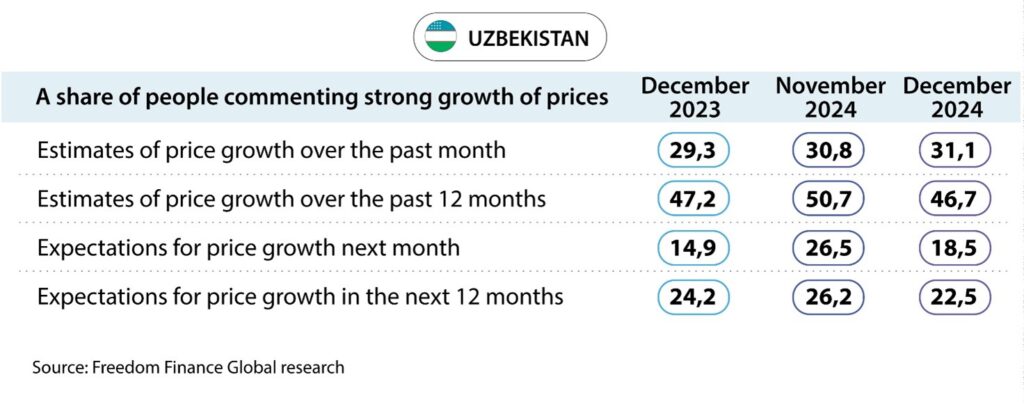
Devaluation expectations have finally subsided
In December, devaluation expectations of Uzbekistan residents decreased compared to November and turned out to be the lowest in the last 4 months. The Uzbek sum continues to weaken in December. This has been happening for the fifth month in a row; in addition, the growth rate of the dollar reached 0.5%. The share of those who expect the national currency to weaken against the dollar over the next 12 months fell from 60.5% in November to 58.6% in December. On a one-month horizon, the share of pessimists dropped sharply from 43.5 to 39.6%. Although these figures are not the lowest in 2024, they are still noticeably lower than the levels of December 2023.
Kyrgyzstan
In Kyrgyzstan, the Consumer Confidence Index showed neutral dynamics in December. The CCI fell by only 0.1 points over the month and reached 138.5 points. However, residents’ estimates of the favorable conditions for large purchases showed a significant decrease. However, this decrease was offset by a general improvement in forecasts. The past 2024 was successful for Kyrgyzstan, and the Consumer Confidence Index grew by a significant 8.3 points, largely due to improved estimates of the economic situation.
Worsening estimates of favorable conditions for large purchases
In December, the sub-index of current favorable conditions for large purchases fell by 5.4 points and reached 99.5 points, which is the lowest value since April 2024 (when it was at 90.4 points). However, Kyrgyzstan continues to be the leader in Central Asia on this issue; and over the past year, this sub-index has grown by a good 9.3 points. The share of people indicating favorable conditions for large purchases fell from 43.5% in November to 40.4% in December. Compared to the end of 2023, this figure is quite high, because then it was only 36.8%.
Moreover, all age groups demonstrated a monthly decline in optimism. The worst dynamics were noted among young people under 29. There, the share of people who consider the current conditions for large purchases to be at least more favorable fell from 51.1% in November to 45.1% by the end of 2024. Despite this decline, young people still show the best results among all ages. Among other age groups, the decline was a small 1-1.7 p.p. Respondents aged 45–59 gave the worst answers again: the share of optimists reached only 35.5% among them.
However, the dynamics are not so clear-cut across regions. In two regions at once (Jalal-Abad and Osh Regions), a decrease in the share of positive responses by more than 10 p.p. was recorded. Nevertheless, residents of the Chui region again responded worse than others. However, there the share of those who consider the current conditions for large purchases as favorable increased from 29.3 to 35.8%. The leader in December also did not change, and it remains Talas Region, where a similar share was 48%, which is as much as 7.5 p.p. less than in November. It should be noted that the only region that showed a deterioration in 2024 was the Jalal-Abad region.
Economic forecasts rise to record highs
The sub-index of forecasts of changes in the economic situation over the next 12 months increased by 2.8 points in December. The indicator reached 160.7 points, which is a record for the entire research. Almost 69.5% of residents believe that the economic situation will improve, while their share was 67% in November. For 2024, this indicator increased by 4.4 p.p.
Among the age groups, growth is observed across the entire spectrum. Kyrgyzstanis aged 45–59 demonstrated the best monthly dynamics: 70% of them expect an improvement in the economic situation. In November, this figure reached 66.7%. However, the older generation over 60 years continues demonstrating the best results. Among them, the share of positive answers reached 74.6%, which is 1.7 p.p. higher than the November figure. The least optimists were among young people under 29. There, the same figure reached 67.2%, which is slightly higher than a month earlier (66.1%).
In the regional context, the monthly dynamics in forecasts of changes in the economic situation are not so clear. Five regions out of nine showed negative dynamics. However, the decline, except for the Issyk-Kul region, was small. In this region, the share of positively minded people decreased from 76.4 to 69.3%. However, the Talas region showed the worst result this time – 61%. On the other hand, the share of positive responses increased by almost 11 p.p. in the Jalal-Abad region. There, this indicator reached 78.8%, which was a high value in December. The share of optimists also increased in the Naryn Region by a good 8 p.p. We note that for 2024, the Batken and Talas Regions opposed the general trend, where there was a noticeable drop in the indicator.
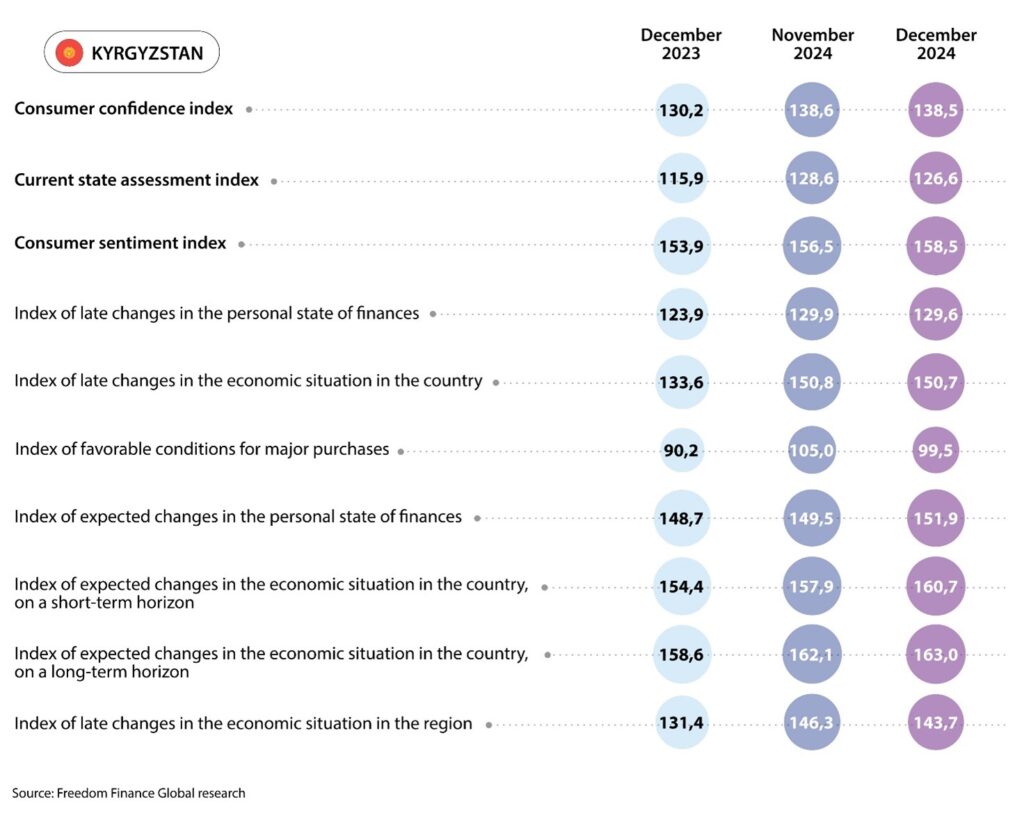
Inflation estimates and expectations remained at the same level
In December, inflation estimates of Kyrgyzstanis showed a neutral result after a significant increase in November. If last month 32.7% of respondents felt a very strong increase in prices over the past month, then such figures were 32.3% in December. Estimates of price growth over the past 12 months increased slightly. In December, 51.1% of Kyrgyzstanis noted an acceleration in their growth, while this figure was 49.6% in November. It should be noted that the November deterioration in inflation estimates is quite consistent with official data, which were not available at the time of publication a month ago. In November, annual inflation accelerated from 4.8 to 5.7% largely due to the rise in prices of vegetables.
Inflation expectations of Kyrgyzstanis have shown a slight decrease and remain relatively low. The share of respondents expecting a faster increase in prices in the next 12 months fell from 13.8 to 12.4%. The share of those who believe that prices will rise very strongly in the next month fell from 10.2 to 9.7%.
Among certain goods and services for which residents noticed the greatest price increase, we continue to note the category of ‘Meat and Poultry’, which has held the first line for the fourth month in a row. The share of respondents who chose it fell by only 1 p.p. over the month and amounted to 46.9%. In general, monthly changes were insignificant among the leading goods, with the exception of sugar and salt. The share decrease in this category was 3.1 p.p. Otherwise, the Top-5 goods for which the greatest price increase is noticeable have not changed for 16 months in a row. In addition to the above-mentioned products, 46.3% of respondents noticed a strong increase in prices for vegetable oil, 44.9% for flour, and 41% for vegetables and fruits in December.
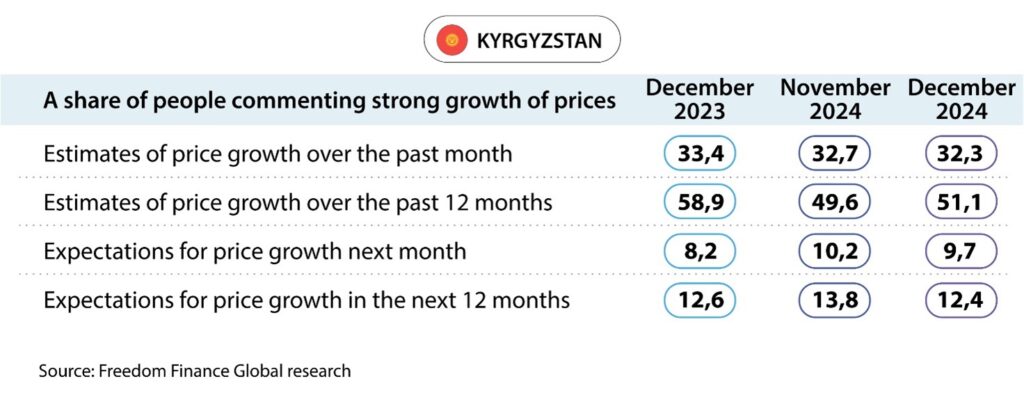
Devaluation expectations have improved significantly
The Kyrgyz som weakened by only 0.2% in December after a more noticeable fall in October-November. As a result, devaluation expectations of Kyrgyzstan residents improved somewhat after two months of growth. If in the previous month, 30.1% of residents expected the national currency to weaken in a year, then the share of such people fell to 27% in December; and the share of pessimists decreased from 21.8 to 18.3% in the issue of dollar growth in the one-month horizon.
Tajikistan
In December, the Consumer Confidence Index showed a sharp decline from 150.9 to 145.1 points in Tajikistan. All five sub-indexes showed a monthly decline, but we especially note a significant deterioration in the estimates of the current favorable conditions for large purchases, which fell sharply to a record low. For 2024, consumer confidence decreased slightly in Tajikistan: by 3.5 points and reached 145.1 points (December 2024 indicator compared to December 2023 indicator).
Conditions for large purchases have worsened sharply
The sub-index, which measures the favorability of current conditions for large purchases and spending, fell sharply by 14.5 points in December compared to November and reached 69.5 points. This was a record low for the entire research. For 2024, the deterioration of this sub-index was an impressive 23.7 points. In December, only 33.5% of respondents gave positive answers, while there were 40.9% in the previous month. A year ago, as many as 45.6% of residents considered the current conditions for large purchases as favorable.
Among the age groups, there was a completely negative trend. The most noticeable decline was recorded among people aged 30–44. In November, the share of optimists reached 39.6% in this age group, but it fell to 29% in December. This value became the lowest at the end of 2024. The older generation over 60 responded best. However, the share of optimists fell from 43.1 to 36.5%. A significant monthly deterioration (by 8.4 p.p.) was also observed among young people under 29. On the other hand, we note the insignificant negative dynamics of the group of respondents aged 45–59. Among them, the same indicator fell from 35.9 to 35.4%.
In the regional context, the deterioration is not observed everywhere. In the Gorno-Badakhshan Autonomous Region, the share of people who consider current conditions as favorable for large purchases increased from 51.8 to 53%. This is significantly higher than the figures for all other regions, where the share fell by 7-10 p.p. per month. The share of optimists fell most noticeably in the districts of republican subordination: from 40.2 to 30.1%. This result was the worst among all regions of the country.
Deterioration in estimates of personal financial situation
In Tajikistan, residents’ estimates of changes in their personal financial situation also showed a significant deterioration compared to November. This sub-index fell from a record 153.7 to 147.5 points, which is nevertheless the second-best result and 2 points higher than at the end of 2023. The share of optimistic Tajikistanis was 66.3% in December versus 73.2% in November. A year ago, this figure reached 64%.
Among the age groups, a decrease in the share of optimists was recorded in all age groups. This is most pronounced among residents of the country aged 45–59, where the share of those who positively estimated changes in their personal financial situation fell from 73.1 to 62.5%. Respondents aged 30–44 demonstrated almost the same drop: from 68.9 to 58.6%, which was the worst result in December. Young people under 29 responded best, where the share of positive answers fell from 77.7 to 74.2% over the month.
In this issue, a monthly decline in the share of optimists was recorded in all regions, with the exception of the Gorno-Badakhshan Autonomous Region. There, the share of those who noted an improvement in their personal financial situation over the past 12 months increased from 75.7 to 87.7%, which is tens of p.p. higher than the values of all other regions. On the other hand, the greatest decline in the share is observed in the districts of republican subordination, where it decreased from 69.1 to 57.5%. This became the worst indicator of the month, and the region retained its title of outsider.
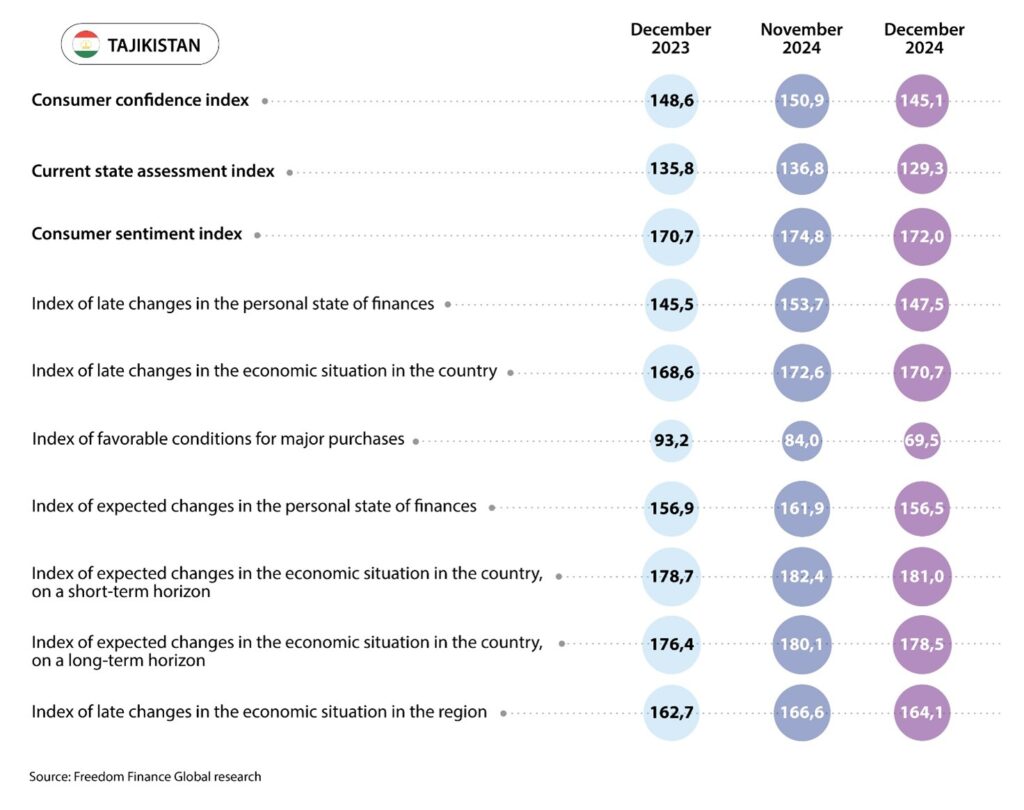
Inflation sentiment improved slightly
In December, inflation estimates by Tajikistanis showed a slight decrease after the same insignificant growth in November. The share of respondents who noted a strong increase in prices over the past month fell from 26.4 to 23.8%. In the horizon of the past 12 months, the share of those who felt a faster increase in prices decreased from 28 to 27.2%. Inflation expectations of residents of Tajikistan showed less significant monthly dynamics. About 11.7% of residents expect a very strong increase in prices in the coming month, while there were 11.6% in November; and in the horizon of the next 12 months, the share of pessimists fell from 13.7 to 12.4%.
Official inflation data for December has not yet been published, but annual inflation accelerated again in November from 3.6 to 4.1%. Among certain goods, residents of Tajikistan continue to be greatly concerned about the prices of Meat and Poultry. Over the past month, the share of people who have noticed a strong increase in prices for this category has remained virtually unchanged and amounted to 50.8%. However, the level of concern has increased significantly for other food products after the November drop. For vegetable oil – from 26 to 33.2%, this figure increased from 26.4 to 30.1% for flour, and for fruits and vegetables – from 15 to 21.7%. It should be noted that these four food products continue to remain leaders throughout the entire research. According to official statistics, the growth of prices for meat and meat products slowed down in November increasing by 1.2% MoM, and for beef separately – by 2.2% MoM, which had a positive effect on the share of respondents who noted this. Thus, over the year, meat as a whole has already risen in price by 17.3%, and beef – by 29.3%. Among other food products, a monthly price decline was shown by fruits (-2.6% MoM) and flour (-1.3% MoM). On the other hand, vegetable and animal oil is again rising in price by 2.6% MoM.

Devaluation expectations have eased slightly
In December, devaluation expectations showed a slight decrease in Tajikistan after a noticeable growth in November. Let us recall that the dollar exchange rate against the somoni in December grew by more than 0.6%, which is significantly lower than in November when the growth was 2%. The share of those who expect the national currency to weaken within a month increased from 19.5 to 19.6%. However, 26.8% of the country’s population expects a weakening in the next year (28.8% in November).
Conclusions
The last month of 2024 turned out to be moderately positive for the Central Asian countries in terms of inflation and expectations of weakening national currencies. In Kazakhstan, the Consumer Confidence Index recovered after a decline in November. As a result, 2024 ended neutrally for Kazakhstan. Consumers showed slightly more confidence in favorable conditions for large purchases than a year earlier. On the other hand, forecasts for 12 months ahead slightly worsened. In Uzbekistan, the monthly dynamics were neutral after a weak November. Overall, consumer confidence significantly decreased in 2024 in Uzbekistan giving way to Kyrgyzstan in the second position of the rating. Uzbekistanis showed a general decrease in optimism on all five issues. Residents of the country are least confident in improving their personal financial situation in the next 12 months. Overall, over the year, the share of respondents who positively estimated the actual improvement of both their personal financial situation and the economic situation has decreased.
In Kyrgyzstan, the CCI also showed neutral dynamics in December after good growth in November. As a result, the past year turned out to be positive for Kyrgyzstan, as significantly more residents showed higher consumer confidence than in 2023. The number of people, who noticed an improvement in the economic situation, as well as conditions for large purchases, significantly exceeds last year’s figure. In general, more Kyrgyzstanis have positive forecasts for both their personal financial situation and the economy. As a result, Kyrgyzstan ends the year in second place in Central Asia. The regional leader in the CCI, Tajikistan, experienced a sharp monthly decline in consumer confidence in December. Overall, the index has dropped quite noticeably in 2024. Nevertheless, Tajikistan’s lead is still significant, despite its decline in December. It should be noted that then, as well as over the past year as a whole, far fewer residents of the country considered the conditions for large purchases as favorable. Moreover, the annual dynamics of three indicators at once were positive, but a strong and sharp decline in optimism on the above-mentioned issue pulled overall consumer confidence down.
Inflation estimates and expectations showed a positive trend in December across the region after pessimistic November, September and August. It is worth noting that inflation sentiment at least remained at the same level or slightly improved across the region. In Kazakhstan, inflation expectations declined significantly after multi-month highs in November. On the other hand, inflation estimates continued to decline slightly. In Kyrgyzstan, a slight decline in inflation estimates was also offset by a moderate decline in expectations of strong price growth. In Uzbekistan, respondents’ inflation sentiment improved significantly, especially in terms of expectations. The November surge was one-time, and the share of those expecting strong price growth returned to previous levels. Inflation estimates also improved in Uzbekistan but to a lesser extent. In Tajikistan, inflation sentiment dynamics are similarly positive, but its pace is not as high as in the Central Asian countries under research. Residents’ inflation estimates have dropped significantly, and expectations of a price jump for the year ahead have also noticeably fallen.
Devaluation expectations generally showed a decrease in Central Asian countries, except for Kazakhstan, where the growth of these expectations continues for the third month in a row amid new historical records of the dollar-to-tenge exchange rate. The indicators once again updated the records for the entire research. In Kyrgyzstan, after two months of growth in devaluation expectations, there was some improvement amid a slow weakening of the som in December. In Tajikistan, after a sharp increase in November, the share of those expecting dollar growth over the year decreased in December. However, the indicators remain overstated, especially in comparison with the end of 2023. In Uzbekistan, after a neutral November, devaluation expectations decreased for the first time since August after a slight weakening of the sum in December. Overall, 2024 turned out to be positive in this regard, as the share of pessimists fell by about 8 p.p. in the country.
The eighteenth wave of the consumer confidence survey in four Central Asian countries showed relatively positive results in terms of countries and key issues. Two countries showed neutral dynamics in consumer confidence, while the other two showed both growth and decline. Last year 2024 did not end well for the region, as two countries showed a decrease in consumer confidence. While the decline in Tajikistan’s results was not the sharpest, the decline in confidence was much more noticeable in Uzbekistan. Amid a sharp improvement in the sentiments of Kyrgyzstanis, this led to Uzbekistan losing its second place in the ranking of countries. Kazakhstan, while occupying the last place, continues to show neutral annual dynamics. It should be noted that, in general, all four countries ended the year in the positive zone, and in general, positive responses from residents significantly prevail over negative ones, except for Kazakhstan, where this difference is insignificant. As for inflation sentiment, it has noticeably worsened in late summer across the region. In particular, inflation expectations have grown quite noticeably compared to 2023. Devaluation expectations in 2024 showed neutral dynamics on average. While Kazakhstan and Tajikistan saw growth, residents in the other two countries were more optimistic than at the end of 2023.













